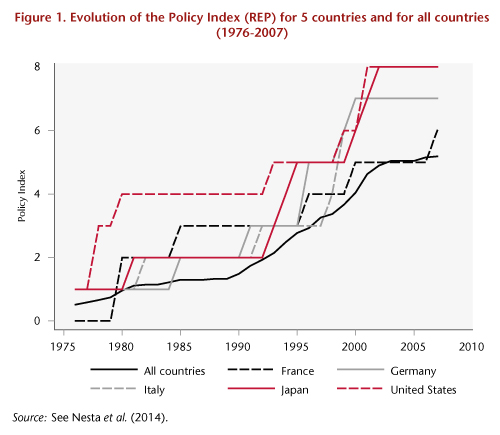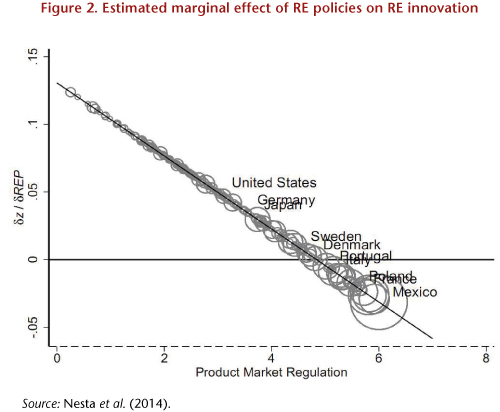Is Emmanuel Macron approving a new industrial policy for France?
Support for industry is an economic issue that wins adherence from both Right and Left. The entire French political spectrum agrees on the importance of industry for the economy’s future. There is also a consensus among economists, who bring together a variety of sensitivities in recognizing the leading role industry plays in driving growth, mainly through exports and innovations – the manufacturing sector is responsible for over 70% of total exports and more than 75% of total R&D spending. This consensus is even international, to such an extent that, paraphrasing Robert Reich, it could be said that, “on the battlefield of national economic ambition, industry is the new boots on the ground”.
In France, everyone also agrees on deploring the decline in industrial jobs and more generally the de-industrialization that has seen industry’s share of total employment fall from 25% in 1990 to 10% in 2014. Deindustrialization, which has intensified since the 2007 crisis, crystallizes all the concerns about globalization and all the reproaches made to the French fiscal and regulatory environment.
Governments in general have been quick to support industry and have set up programmes to support innovation, SMEs and R&D spending. The research tax credit (CIR) set up in 1983 has been reinforced by government after government, and perfectly illustrates the political consensus on the matter. But since then numerous programmes to aid companies have been added, creating a tangle of schemes and local and national institutions, leading a recent OECD report to label the result relatively incoherent.
Unfortunately, it is clear that France’s economic and political consensus has not led to making its industry a global singularity in terms of performance. The country’s industrial policy has been unable to counteract the inexorable decline of industry in the face of the service sector.
But judging industrial policy in this way misconstrues its possible objectives. To understand what industrial policy involves, we need to shed our old habits.
On the one hand, opposing industry to services is outdated and is merely a statistical artefact. The services sector is poised to take over innovation and exports, but our statistics have not yet taken stock of these changes. We are still not very clear on how to measure productivity in services or how to understand the channels for innovation in this sector, which do not necessarily pass through R&D. Note, however, that among the companies that benefit from the CIR research tax credit, the number of services firms is increasing every year, reflecting their growing contribution to private R&D spending. Services are a very heterogeneous category: the “Information and communication” category, for example, is less distant from the manufacturing sector than from the real estate business. Furthermore, exports of services are still not well measured (or declared) and are not always very distinguishable from movements of capital. Veiled behind these imperfections in statistics, globalization is not sparing the services sector, which will form an increasing share of international transactions.
Still, for the moment, it is undeniable that the manufacturing sector governs R&D’s share of GDP and that the decline in France’s market share reveals the productive difficulties companies are experiencing. But we must begin now to anticipate the changes taking place in the boundaries between sectors and not become locked into a reading of economic activity that is incapable of grasping the areas where added value will be created in the future. Re-industrialization in the sense of increasing the role of manufacturing (or “a return to the age of doing”) is not necessarily the salvation of the economy of the future.
At the same time, industrial policy as such was not responsible for de-industrialization, nor is it able to counteract the decline in industrial employment.
The reasons for de-industrialization – beyond the important role played by technical progress – are to be found in the conditions governing the exercise of economic activity in France relative to the rest of the world: from the incentives to innovate to the incentives to invest, from taxation to regulation, from skills to productivity.
To put it another way, industrial policy was not the cause of the difficulties of Alstom, of AREVA or of Nokia’s takeover of Alcatel-Lucent, and even less so of the logistics merger of Norbert Dentressangle and XPO.
It should be recognized that France’s industrial policy is sometimes erroneously confused with what some call “industrial engineering”. As public companies have historically been the spearhead of industrial policy, policy had the distinctive feature of combining industrial logic with the logic of the economic and political powers, and the two were not always in synch. These inconsistencies could exacerbate the difficulties facing State-owned enterprises.
Industrial policy should content itself with boosting technological trajectories and promoting business growth. The renovation of industrial policy will involve a comprehensive approach to future technologies. The mechanisms for this will include the development of public-private partnerships and the outsourcing of operations to long-term independent administrative agencies. In this respect the political consensus needs to be extended to include the means for this in order to ensure the continuity of these agencies, so as to stabilize the institutional landscape in which business operates.
Industrial policy is the expression of technological orientations. It can be more or less interventionist and can go beyond more or less simple declarations of intent based on the budgets it is given, depending on overall budgetary constraints. It is especially critical that public funds are committed or private funds are directed so as to finance the demand placed on business. But it is necessary for this public financing to correspond to a genuine request by the State, such as the need for defence equipment to meet foreign policy or the conquest of space, or to a real decision to involve society in its use, such as green energy. Furthermore, in a democracy, the State’s request needs to have the support of society, which should be willing to finance, for example, green energy by paying more for carbon and fuel, along the lines of what has been done in Germany.
In this sense, Emmanuel Macron’s approach to industrial policy reflects a positive development. Cutting 34 future projects down to fewer than a dozen is relevant, because it helps to clarify the State’s commitments and make them more credible. In addition, the digital commitment is the transcription of a technological choice. At the moment “re-industrialization” is focused around the industries of the future, the digitization and modernization of industrial facilities. It would be more honest to dispense with the goal of “re-industrialization” since what is needed is to deal with the economy as a whole and modernize the means of production in order to make France’s productive tissue out of a new stronger fabric.
However, the stated objectives are not based on very risky technological choices and do not commit many resources: a 2.5 billion euro tax benefit for companies investing in their productive facilities over the next 12 months (the accelerated capital cost allowance – “sur-amortization” – announced a month ago) and 2.1 billion euros in additional development loans by BPI France for SMEs and ETI over the coming two years. This will thankfully not entail creating another intermediation body for the new policy. As for the role of the State shareholder, the speech was more serene vis-à-vis globalization and more encouraging with regard to European cooperation – as has been shown in the reaction to Nokia’s merger process with Alcatel Lucent. The Minister’s decisions do not however seem to be departing from a full neutrality, as can be seen in the case of the double voting shares that the State has imposed on Renault.
The overhaul of industrial policy remains modest in terms of resources and goals, but it has the merit of setting objectives for policy that it might actually be able to meet.

